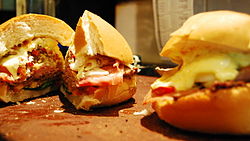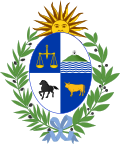food.wikisort.org - Dish
Chivito is the national dish of Uruguay.[2][3] It is a thin slice of tender cooked beefsteak (churrasco), with mozzarella, ham, tomatoes, mayonnaise and black or green olives, and commonly also bacon and fried or hard-boiled eggs, served as a sandwich in a bun, often accompanied by French-fried potatoes.[4][5] Other ingredients, such as red beets, peas, grilled or pan-fried red peppers, and slices of cucumber, may be added.[6][7]
This article needs additional citations for verification. (June 2011) |
 | |
| Type | Sandwich |
|---|---|
| Place of origin | |
| Created by | Antonio Carbonara[1] |
| Main ingredients | Bun, churrasco beef, bacon, fried or hard-boiled eggs, ham, black or green olives, mozzarella, tomatoes, mayonnaise |


| This article is part of a series on the |
| Culture of Uruguay |
|---|
 |
|
Uruguay Portal |
In Argentina a sandwich of this sort is called lomito.
Origin
Chivito is the diminutive of chivo, goat, and means kid (young goat). In neighboring Argentina, chivito, barbecued kid, is a popular asado dish; it is reported that the Uruguayan chivito arose in Punta del Este, Uruguay, at a restaurant called "El Mejillón Bar" in 1946, when a woman[8][9][10] from Argentina ordered a sandwich of chivito for a hurried meal, expecting kid.[1] The restaurant owner, Antonio Carbonaro, did not have this meat and used beef fillet steak instead.[11][12]
Variations
The Canadian Chivito (in Spanish chivito canadiense) is a variation of the sandwich, with the addition of panceta.[13]
The chivito can be served as a platter rather than a sandwich (chivito al plato).[12] It is usually served with Russian salad or French fries.
See also
- List of sandwiches
- Roast beef sandwich
References
- "Abandon Hope All Ye Who Enter 2010 with New Year's Resolutions! Behold, El Chivito!". weareneverfull.com. Retrieved 8 May 2018.
- "The World's Best Street Food".
{{cite web}}: CS1 maint: url-status (link) - Burford, Tim. "Bradt Travel Guide Uruguay".
{{cite web}}: CS1 maint: url-status (link) - Caskey, Liz (2010). Knack South American Cooking: A Step-by-Step Guide to Authentic Dishes Made Easy. Guilford, CT, USA: Globe Pequot Press. pp. 148–149. ISBN 978-1-59921-918-9.
- Bernhardson, Wayne (2008). Moon Buenos Aires. Berkeley, CA, USA: Avalon Travel div. of Perseus Books Group. p. 74. ISBN 978-1-56691-991-3.
- "The Best Moments From Anthony Bourdain's Visit to Uruguay on 'Parts Unknown'". eater.com. Retrieved 8 May 2018.
- "A sandwich is just a sandwich, but in Uruguay, the chivito is a national emblem". explorepartsunknown.com. 2 May 2018. Retrieved 8 May 2018.
- "EL CHIVITO, EL BOCATA MÁS POPULAR DEL MUNDO. | galiciaunica".
- S.L, Titania Cía Editorial. "El chivito, el sandwich uruguayo que hizo feliz al Che e incomodó a Sabina - Sábado, 08 Noviembre 2014 13:55". El Confidencial.
- "El chivito, el sandwich uruguayo que hizo feliz al Che e incomodó a Sabina". La Vanguardia.
- "Historia de la creación de "El Chivito"" [History of the creation of "el chivito"]. Archived from the original on 22 October 2013.
- "Murió el inventor del chivito uruguayo" [The inventor of the "chivito uruguayo" has died]. La Nacion (Buenos Aires, Argentina) (in Spanish). 11 November 2003. Retrieved 27 August 2017.
- "Chivito Canadiense". Radio Nacional (Uruguay) (in Spanish). 8 April 2017. Archived from the original on 28 December 2017. Retrieved 27 August 2017.
Further reading
- History of the Chivito from the local government in Maldonado (Spanish only)
- invention of the Chivito (Spanish only)
External links
![]() Media related to Chivito at Wikimedia Commons
Media related to Chivito at Wikimedia Commons
На других языках
- [en] Chivito (sandwich)
[es] Chivito
El chivito es un sándwich de carne vacuna y otros ingredientes, generalmente aderezado con mayonesa y acompañado de papas fritas, algunas veces con ensalada rusa u otra guarnición. Se inventó en Punta del Este, Uruguay.[ru] Чивито
Чивито (исп. Chivito ) — национальное блюдо Уругвая [1][2]. Представляет собой сэндвич в булочке с тонким ломтиком нежного приготовленного говяжьего стейка (чурраско) с моцареллой, ветчиной, помидорами, майонезом и чёрными или зелёными оливками, а также обычно беконом, жареными или сваренными вкрутую яйцами, часто с жареным картофелем по-французски [3][4]. Могут быть добавлены другие ингредиенты, такие как красная свекла, горох, красный перец, приготовленный на гриле или на сковороде, и ломтики огурца [5][6].Другой контент может иметь иную лицензию. Перед использованием материалов сайта WikiSort.org внимательно изучите правила лицензирования конкретных элементов наполнения сайта.
WikiSort.org - проект по пересортировке и дополнению контента Википедии
